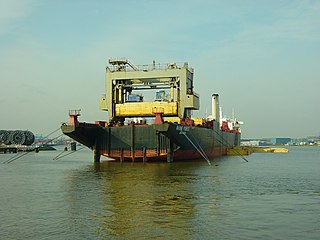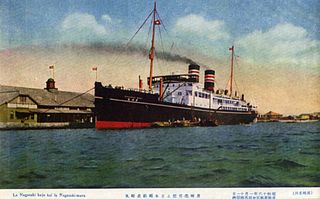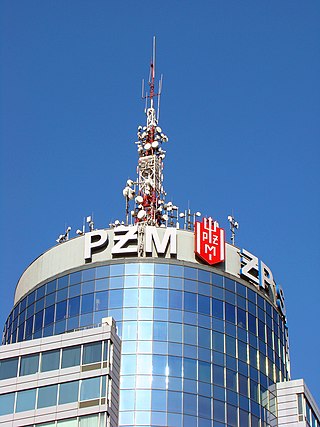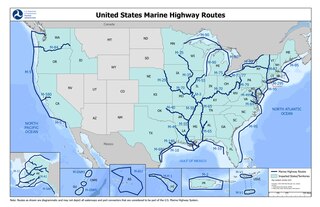
The St. Lawrence Seaway is a system of locks, canals, and channels in Canada and the United States that permits oceangoing vessels to travel from the Atlantic Ocean to the Great Lakes of North America, as far inland as Duluth, Minnesota, at the western end of Lake Superior. The seaway is named for the St. Lawrence River, which flows from Lake Ontario to the Atlantic Ocean. Legally, the seaway extends from Montreal, Quebec, to Lake Erie, and includes the Welland Canal. Ships from the Atlantic Ocean are able to reach ports in all five of the Great Lakes, via the Great Lakes Waterway.

A ship is a large vessel that travels the world's oceans and other navigable waterways, carrying cargo or passengers, or in support of specialized missions, such as defense, research and fishing. Ships are generally distinguished from boats, based on size, shape, load capacity and purpose. Ships have supported exploration, trade, warfare, migration, colonization, and science. Ship transport is responsible for the largest portion of world commerce.

Maritime transport or more generally waterborne transport, is the transport of people (passengers) or goods (cargo) via waterways. Freight transport by sea has been widely used throughout recorded history. The advent of aviation has diminished the importance of sea travel for passengers, though it is still popular for short trips and pleasure cruises. Transport by water is cheaper than transport by air or ground, but significantly slower for longer distances. Maritime transport accounts for roughly 80% of international trade, according to UNCTAD in 2020.

A port is a maritime facility comprising one or more wharves or loading areas, where ships load and discharge cargo and passengers. Although usually situated on a sea coast or estuary, ports can also be found far inland, such as Hamburg, Manchester and Duluth; these access the sea via rivers or canals. Because of their roles as ports of entry for immigrants as well as soldiers in wartime, many port cities have experienced dramatic multi-ethnic and multicultural changes throughout their histories.

A waterway is any navigable body of water. Broad distinctions are useful to avoid ambiguity, and disambiguation will be of varying importance depending on the nuance of the equivalent word in other ways. A first distinction is necessary between maritime shipping routes and waterways used by inland water craft. Maritime shipping routes cross oceans and seas, and some lakes, where navigability is assumed, and no engineering is required, except to provide the draft for deep-sea shipping to approach seaports (channels), or to provide a short cut across an isthmus; this is the function of ship canals. Dredged channels in the sea are not usually described as waterways. There is an exception to this initial distinction, essentially for legal purposes, see under international waters.

A container ship is a cargo ship that carries all of its load in truck-size intermodal containers, in a technique called containerization. Container ships are a common means of commercial intermodal freight transport and now carry most seagoing non-bulk cargo.

Mitsui O.S.K. Lines is a Japanese transport company headquartered in Toranomon, Minato, Tokyo, Japan. It is one of the largest shipping companies in the world.

A cargo ship or freighter is a merchant ship that carries cargo, goods, and materials from one port to another. Thousands of cargo carriers ply the world's seas and oceans each year, handling the bulk of international trade. Cargo ships are usually specially designed for the task, often being equipped with cranes and other mechanisms to load and unload, and come in all sizes. Today, they are almost always built of welded steel, and with some exceptions generally have a life expectancy of 25 to 30 years before being scrapped.

A merchant ship, merchant vessel, trading vessel, or merchantman is a watercraft that transports cargo or carries passengers for hire. This is in contrast to pleasure craft, which are used for personal recreation, and naval ships, which are used for military purposes.

The Port of Hong Kong located by the South China Sea, is a deepwater seaport dominated by trade in containerised manufactured products, and to a lesser extent raw materials and passengers. A key factor in the economic development of Hong Kong, the natural shelter and deep waters of Victoria Harbour provide ideal conditions for berthing and the handling of all types of vessels. It is one of the busiest ports in the world, in the three categories of shipping movements, cargo handled and passengers carried. This makes Hong Kong a Large-Port Metropolis.

Lake freighters, or lakers, are bulk carriers operating on the Great Lakes of North America. These vessels are traditionally called boats, although classified as ships. Freighters typically have a long, narrow hull, a raised pilothouse, and the engine located at the rear of the ship.

The lighter aboard ship (LASH) system refers to the practice of loading barges (lighters) aboard a bigger vessel for transport. It was developed in response to a need to transport lighters, a type of unpowered barge, between inland waterways separated by open seas. Lighters are typically towed or pushed around harbors, canals or rivers and cannot be relocated under their own power. The carrier ships are known variously as LASH carriers, barge carriers, kangaroo ships or lighter transport ships.

A shipping line or shipping company is a company whose line of business is ownership and operation of ships.

Polska Żegluga Morska known as Polsteam or PŻM, is a cargo ship operator based in Szczecin, Poland. Polsteam is a state-owned enterprise with around 3,000 employees.

In 1961 China established a state-run maritime shipping company and subsequently signed shipping agreements with many countries, laying the foundation for developing the country's ocean transport. That organization developed into the present-day China Ocean Shipping (Group) Company (COSCO). The Chinese government also invested heavily in water transport infrastructure, constructing new ports and rebuilding and enlarging older facilities.

Fednav is a privately owned Canadian company in the maritime transport industry, involved in transporting over 30 million tonnes of bulk cargo and break bulk cargo worldwide. Its fleet comprises approximately 120 long-term and spot-chartered vessels. The fleet includes most of St. Lawrence Seaway's maximum-sized bulk carriers, Supramax, and Panamax vessels.

The Type C4-class ship were the largest cargo ships built by the United States Maritime Commission (MARCOM) during World War II. The design was originally developed for the American-Hawaiian Lines in 1941, but in late 1941 the plans were taken over by the MARCOM.

The United States Marine Highway Program is a United States Department of Transportation (DOT) initiative authorized to increase use of the United States' 29,000 mi (47,000 km) of navigable waterways to alleviate traffic and wear to the nation's highways caused by tractor trailer traffic. The program is managed by the Maritime Administration's Office of Ports & Waterways Planning.

The Haldia Dock Complex (HDC) is a docking facility on the Hooghly River in Haldia, West Bengal, India. It is one of the two dock systems under the Syama Prasad Mookerjee Port, Kolkata, with the other being the Kolkata Dock System (KDS). The facility specializes in handling dry and liquid bulk cargo. It is located about 130 kilometres (81 mi) from the sandheads–deep sea area of the Bay of Bengal, 45 kilometres (28 mi) upstream from Pilotage Station at Sagar and 104 km downstream of Kolkata. In 1968, an oil jetty was commissioned at Haldia, and officially in 1977 the dock facility of Haldia started functioning.
Pacific Far East Line, also called PFEL in short, was a passenger and cargo shipping line founded in 1943 by Thomas E. Cuffe, in San Francisco, California. At the beginning he started by chartering foreign ships to run the lines in tramp trade. Later scheduled cargo services were added to the line. During World War II the South Atlantic steamship line was active with charter shipping with the Maritime Commission and War Shipping Administration.





















